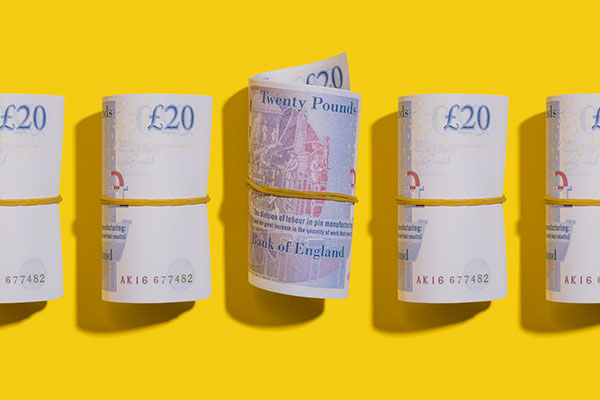Is it time to come out of cash? And what to buy now
Cash rates will fall as the Bank of England cuts interest rates, writes Sam Benstead.
4th November 2024 09:31
by Sam Benstead from interactive investor

One of the most significant investment themes of the past two years has been the rise in popularity of money market funds.
On our platform, assets in money market funds have risen 1,100% (a 12-fold increase) in the past two years.
- Invest with ii: Money Markets| Bond Yields| Tax Rules for Bonds & Gilts
Popular funds include Royal London Short Term Money Market, abrdn Sterling Money Market and L&G Cash Trust.
These funds use “ultra-short” bonds – which generally mature in just a couple of months – as well as bank deposits to achieve a “cash-like” return. Yields follow the Bank of England interest rate closely, so as interest rates rose, so have money market returns.
Rates shot up from 0.1% to 5.25% to combat rising inflation, but the central bank has now begun its rate-cutting cycle. While interest rates have only fallen to 5%, economists expect rates to end the year at 4.25%, and then to keep falling in 2025.
This is because inflation now appears to be under control, having sunk to 1.7% in the year to September.
While money market funds currently yield around 5%, returns are therefore set to fall. Economists at abrdn forecast the Bank of England rate to reach 3.75% by 2025 and 2.75% by 2026.
- The highest-yielding money market funds to park your cash in
- Bond Watch: are 7.5% bond yields too good to be true?
There are many good reasons to be invested in money market funds. They are a safe haven when stock and bond markets are volatile, and returns have been strong relative to recent history.
Also, some money should, of course, be in cash-like instruments, such as sums earmarked for upcoming spending.
However, there are costs. The most important is that while cash does deliver a return, it’s not likely to be much more than inflation, and could even dip below the inflation rate, leading to a loss in purchasing power.
On the other hand, companies are able to raise prices and increase their profits, and so returns from the stock market generally outstrip inflation.
Over 120 years of data, UBS finds that US equities have delivered a 6.4% return above the inflation rate annually on average, and UK shares have produced a 5.3% “real” annual return.
While money market funds have ticked up about 4% so far this year (at the time of writing, 23 October), a global tracker would have made you 16% and a FTSE 100 tracker about 11.5%.
- How have wealth preservation trusts fared over the past five years?
- Sign up to our free newsletter for investment ideas, latest news and award-winning analysis
Bonds also generally deliver better returns that beat money market funds, especially during a rate-cutting cycle.
This is because bonds tend to rise when interest rates fall, as the fixed income they offer becomes more attractive when newly issued bonds yield less. Therefore, prices of existing bonds rise to bring yields to market rates.
Money market funds do not offer this advantage, but will not fall either if interest rates rise.

What could you move your cash into?
Ourquarterly ii Top 50 Index revealed a number of interesting trends about what investments are currently popular, based on the number of buy trades.
The first is that equity index funds are increasing popular. Via open-ended index funds, or exchange-listed ETFs, customers are increasingly seeking to “own the market” rather than handing the reins to a stock picker, all for a larger fee.
There were 30 passive funds in the most-popular 50 investment strategies on the ii platform, up from 26 in the second quarter. Consequently, just 20 active funds made the list, down from 24 in the last report.
- ii Top 50 Fund Index: most-bought funds, trusts and ETFs in Q3 2024
- Terry Smith: two reasons why I haven’t bought Nvidia
The most popular fund was VUSA, an ETF from Vanguard that tracks the S&P 500 index of America’s largest companies. This ETF pays out any dividend income, while VUAG tracks the same market but reinvests it.
The ETFs are up 21% this year, ahead of the average return of 17.5% for US equity funds. Over a decade, the tracker funds are up 345%, well ahead of the sector return of 278%, which shows just how effective it has been to own US shares passively.
However, US shares are expensive, trading on price-to-earnings (p/e) ratio of 27.4x, according to Vanguard. This is nearly double the FTSE 100’s p/e of 15x.
Other popular passive funds include L&G Global Technology Index Trust, HSBC FTSE All World and iShares Physical Gold ETC.
The price of gold has hit a new all-time high this year, driven by falling interest rates and geopolitical tension in the Middle East.
The most popular active funds currently on the ii platform include Jupiter India, Scottish Mortgage, and JPMorgan Global Growth & Income.
- Top 10 most-bought investment funds: October 2024
- Top 10 most-popular investment trusts: October 2024
Indian equities are on a strong run, with investors excited about the young population, strong economic growth, and healthy democracy. However, shares are expensive relative to recent history.
Meanwhile, Scottish Mortgage gives investors access to innovative companies, both private and listed, including the likes of SpaceX, Nvidia and Amazon.
JPMorgan Global Growth & Income has both an income and a growth objective. It yields 4.1%, paying some of this out of capital, and also owns growth-oriented businesses such as TSMC, Apple and Meta Platforms.
Renewable energy infrastructure is another popular sector currently. Four investment trusts from this sector featuring in our index are: Greencoat UK Wind, NextEnergy Solar Fund, The Renewables Infrastructure Group, and Gore Street Energy Storage Fund.
They offer strong yields of around 7% currently, but shares have been volatile and sensitive to interest rate changes.
Bonds could be also an interesting area to consider for those defensively invested who are looking to move out of cash.
An interest-rate cutting cycle, spurred on by lower inflation, is generally good news for fixed income.
On top of that, yields on the safest government bonds are around 4%, with investment grade corporate bonds delivering yields of a little over 5%.
Our Super 60 list of fund ideas includes nine bond funds. These range from plain vanilla sterling corporate bonds, such as Invesco Sterling Bond and Royal London Corporate Bond, to more adventurous global bond funds, such as Jupiter Strategic Bond and M&G Emerging Markets Bond.
These articles are provided for information purposes only. Occasionally, an opinion about whether to buy or sell a specific investment may be provided by third parties. The content is not intended to be a personal recommendation to buy or sell any financial instrument or product, or to adopt any investment strategy as it is not provided based on an assessment of your investing knowledge and experience, your financial situation or your investment objectives. The value of your investments, and the income derived from them, may go down as well as up. You may not get back all the money that you invest. The investments referred to in this article may not be suitable for all investors, and if in doubt, an investor should seek advice from a qualified investment adviser.
Full performance can be found on the company or index summary page on the interactive investor website. Simply click on the company's or index name highlighted in the article.